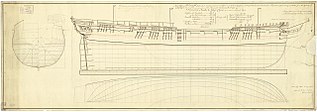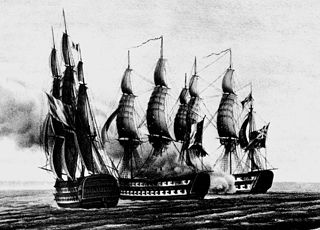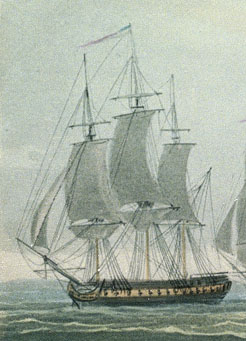
HMS Naiad was a Royal Navy fifth-rate frigate that served in the Napoleonic Wars. She was built by Hall and Co. at Limehouse on the Thames, launched in 1797, and commissioned in 1798. She served in the French Revolutionary and Napoleonic Wars, and her last actions occurred in 1824–5. She was paid off in 1826. She then served for many years in Latin America as a coal depot, first for the Royal Navy and then for the Pacific Steam Navigation Company. She was broken up in 1898, 101 years after her launching.

HMS Sirius was a 36-gun fifth-rate frigate of the Royal Navy. Between 1797 and 1805, the Sirius was engaged in maintaining the blockade of Napoleonic Europe. She was lost in 1810 when her crew scuttled her after she grounded during the Battle of Grand Port.

HMS Swiftsure was a 74-gun third rate ship of the line of the British Royal Navy. She spent most of her career serving with the British, except for a brief period when she was captured by the French during the Napoleonic Wars in the action of 24 June 1801. She fought in several of the most famous engagements of the French Revolutionary and Napoleonic Wars, fighting for the British at the Battle of the Nile, and the French at the Battle of Trafalgar.

HMS Minerva was a 38-gun fifth-rate Royal Navy frigate. The first of four Minerva-class frigates, she was launched on 3 June 1780, and commissioned soon thereafter. In 1798 she was renamed Pallas and employed as a troopship. She was broken up in 1803.
HMS Spencer was a 74-gun third-rate ship of the line of the Royal Navy, launched on 10 May 1800 at Bucklers Hard. Her designer was the French émigré shipwright Jean-Louis Barrallier. She served in two major battles, Algeciras Bay and San Domingo, and in a number of other campaigns. She was broken up in 1822.
HMS Meleager was a 32-gun Amazon-class frigate' that Greaves and Nickolson built in 1785 at the Quarry House yard in Frindsbury, Kent, England. She served during the French Revolutionary Wars until 1801, when she was wrecked in the Gulf of Mexico.

HMS Active was a Royal Navy fifth-rate frigate launched on 14 December 1799 at Chatham Dockyard. Sir John Henslow designed her as an improvement on the Artois-class frigates. She served during the French Revolutionary Wars and the Napoleonic Wars, capturing numerous enemy vessels. Her crews participated in one campaign and three actions that would later qualify them for the Naval General Service Medal. She returned to service after the wars and finally was broken up in 1860.

HMS Mercury was a 28-gun Enterprise-class sixth-rate frigate of the Royal Navy. She was built during the American War of Independence and serving during the later years of that conflict. She continued to serve during the years of peace and had an active career during the French Revolutionary Wars and most of the Napoleonic Wars, until being broken up in 1814.

HMS Argo was a 44-gun fifth-rate Roebuck-class ship of the Royal Navy. She was launched in 1781 from Howdon Dock. The French captured her in 1783, but 36 hours later the British recaptured her. She then distinguished herself in the French Revolutionary Wars by capturing several prizes, though she did not participate in any major actions. She also served in the Napoleonic Wars. She was sold in 1816.

HMS Lark was a 16-gun ship sloop of the Cormorant class, launched in 1794 at Northfleet. She served primarily in the Caribbean, where she took a number of prizes, some after quite intensive action. Lark foundered off San Domingo in August 1809, with the loss of her captain and almost all her crew.
HMS Cynthia was a ship sloop of unusual design, launched in 1796. She took part in one medal-worthy boat action and participated in captures of a number of merchant vessels, was present at two notable occasions, the surrender of the Dutch fleet in the Vlieter Incident and the capture of Alexandria, and her crew participated in two land attacks on forts. She was broken up in 1809.

The action of 7 April 1800 was a minor naval engagement fought between a British squadron blockading the Spanish naval base of Cádiz and a convoy of 13 Spanish merchant vessels escorted by three frigates, bound for the Spanish colonies in the Americas. The blockade squadron consisted of the ships of the line HMS Leviathan and HMS Swiftsure and the frigate HMS Emerald, commanded by Rear-Admiral John Thomas Duckworth on Leviathan. The Spanish convoy sailed from Cádiz on 3 April 1800 and encountered Duckworth's squadron two days later. The Spanish attempted to escape; Emerald succeeded in capturing one ship early on 6 April. The British captured a brig the following morning and the British squadron divided in pursuit of the remainder.

HMS Entreprenante, was a 10-gun cutter that the Royal Navy captured from the French in 1798. The British commissioned her in 1799 and she served during the French Revolutionary and Napoleonic Wars, participating in the Battle of Trafalgar. She has been the only ship of the Royal Navy to bear the name. She took part in several small engagements, capturing Spanish and French ships before she was sold in 1812 for breaking up.

HMS Medusa was a 32-gun fifth-rate frigate of the Royal Navy that served in the Napoleonic Wars. Launched on 14 April 1801, she took part in the action of 5 October 1804 against a Spanish squadron, in the River Plate Expedition in 1807, and made several captures of enemy ships, before being converted to a hospital ship in 1813. She was broken up in 1816.
His Majesty's hired armed cutter Penelope served the Royal Navy from 29 January 1794 until the Spanish navy captured her off Gibraltar on 7 July 1799. The Spaniard then employed her as a guarda costa.
HMS Incendiary was an 8-gun fireship of the Royal Navy. She was present at a number of major battles during the French Revolutionary Wars, and captured, or participated in the capture, of several armed vessels. In January 1801 she was in the Gulf of Cadiz where she encountered Admiral Ganteume's squadron. The 80-gun French Navy ship of the line Indivisible received the credit for the actual capture.

Etna was a French naval Etna-class ship-sloop launched in 1795 that the Royal Navy captured in November 1796. She was taken into service as HMS Aetna and renamed to HMS Cormorant the next year. She captured several merchant vessels and privateers before she was wrecked in 1800 off the coast of Egypt.

HMSEmerald was a 36-gun Amazon-class fifth rate frigate that Sir William Rule designed in 1794 for the Royal Navy. The Admiralty ordered her construction towards the end of May 1794 and work began the following month at Northfleet dockyard. She was completed on 12 October 1795 and joined Admiral John Jervis's fleet in the Mediterranean.
HMS Florentina, was the Spanish frigate Santa Florentina, built in 1786 at Cartagena, Spain to a design completed on 17 October 1785 by José Romero Fernández de Landa, modified from his earlier design for the Santa Casilda. The British Royal Navy captured her on 6 April 1800 and took her into service as HMS Florentina. She served in the Mediterranean until she returned to Britain in 1802 after the Treaty of Amiens. There the Admiralty had her laid-up in ordinary and she was sold in 1803.
El Corso was launched in Spain in 1791 as a naval brig. the British Royal Navy captured her in 1796 and took her into service as HMS Corso. She then served in the Mediterranean where she captured numerous small vessels, the great majority of which were merchant vessels. In 1802 she sailed to England. From July 1802 to her sale in September 1814 she served as a receiving ship.












